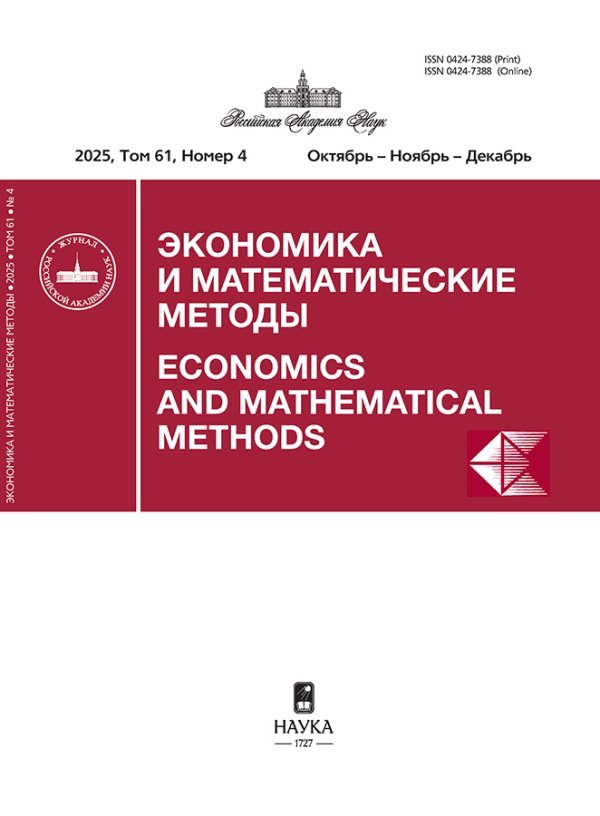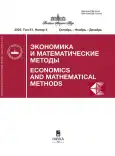The model of a decentralized project tokens allocation
- Authors: Kolesnik G.V.1
-
Affiliations:
- Plekhanov Russian Economic University
- Issue: Vol 61, No 4 (2025)
- Pages: 98-110
- Section: Mathematical analysis of economic models
- URL: https://stomuniver.ru/0424-7388/article/view/697033
- DOI: https://doi.org/10.31857/S0424738825040081
- ID: 697033
Cite item
Abstract
The development of distributed ledger technologies (blockchain) led to the alternative ways to finance projects based on the issuance of tokens — digital accounting units in blockchain platforms. Unlike traditional financing mechanisms, the use of tokens allows for greater flexibility in fundraising and income and management rights allocation among stakeholders. An urgent problem that arises when using this mechanism is to determine the proportions in which tokens are distributed among the stakeholders of the project. Currently, this problem is solved by each project individually, based on its organizers’ subjective vision. In the article, the problem of token allocation of a decentralized project is investigated from the point of view of cooperative game theory. A token allocation model is considered in the form of a three-party cooperative game and the properties of its solutions are investigated, based on the core, Shapley value and nucleolus. The model allows to obtain estimates of rational token allocations corresponding to the participants’ contributions in the project, as well as stable to individual parties and their coalitions deviations. It also makes possible to solve the inverse problem of assessing the contribution of participants and their coalitions to the value of the project based on information about the past token allocation.
Keywords
About the authors
G. V. Kolesnik
Plekhanov Russian Economic University
Email: kolesnik.gv@rea.ru
Moscow, Russia
References
- Авдошин С. М., Цветков Д. Д. (2019). Методика проведения ICO // Информационные технологии. Т. 25. № 10. С. 615–628. doi: 10.17587/it.25.615-628 [Avdoshin S. M., Tsvetkov D. D. (2019). Methodology for ICO Implementation. Information Technologies, 25 (10), 615–628. doi: 10.17587/it.25.615-628 (in Russian).]
- Алиев О. М., Ибрагимова Д. М. (2024). Особенности и факторы успешности проведения ICO // Экономика и предпринимательство. № 7 (168). С. 459–468. doi: 10.34925/EIP.2024.168.7.089 [Aliev O. M., Ibragimova J. M. (2024). Features and success factors of ICO. Economics and Business, 7 (168), 459–468. doi: 10.34925/EIP.2024.168.7.089 (in Russian).]
- Беларев И. А., Стародубцева Е. Б. (2019). ICO как новая форма финансирования инновационного бизнеса // Финансовый журнал. № 5 (51). С. 104–118. doi: 10.31107/2075-1990-2019-5-104-118 [Belarev I. A., Starodubtseva E. B. (2019). ICO as a new form of financing of innovative business. Financial Journal, 5 (51), 104–118. doi: 10.31107/2075-1990-2019-5-104-118 (in Russian).]
- Бритвин С. В., Тарашнина С. И. (2013). Алгоритмы нахождения пред-N-ядра и SM-ядра в кооперативных ТП-играх // Математическая теория игр и ее приложения. Т. 5. № 4. С. 14–32. [Britvin S. V., Tarashnina S. I. (2013). Algorithms of finding the prenucleolus and the SM-nucleolus of cooperative TU-games. Mathematic Games Theory and Applications, 5 (4), 14–32 (in Russian).]
- Колесник Г. В. (2010). Моделирование формирования инвестиционной стоимости инструментов корпоративного контроля // Экономика и математические методы. Т. 46. № 3. С. 93–100. [Kolesnik G. V. (2010). A model of investment value of the corporate control instruments. Economics and Mathematical Methods, 46 (3), 93–100 (in Russian).]
- Кондырев В. А. (2018). Децентрализованные автономные организации: новый путь к принятию решений // Цифровая экономика. № 2. С. 23–30. [Kondyrev V. A. (2018). Decentralized autonomous organizations: A new way to the decision making. Digital Economy, 2, 23–30 (in Russian).]
- Лукасевич И. Я. (2021). Токенизация активов как долгосрочный тренд в корпоративных финансах // Финансы. № 4. С. 36–43. [Lukasevich I.Ya. (2021). Asset tokenization as a long-term trend in corporate finance. Finance, 4, 36–43 (in Russian).]
- Луняков О. В. (2024). Децентрализованные автономные организации (DAO) как новый формат организации сотрудничества // Финансовые рынки и банки. № 5. С. 23–31. [Lunyakov O. V. (2024). Decentralized autonomous organizations (DAO) as a new format for cooperation organizations. Financial markets and banks, 5, 23–31 (in Russian).]
- Матыцин Д. Е. (2023). Развитие правового регулирования ключевых технологий Индустрии 4.0: цифровые токены как особые инвестиционные инструменты // Правовая парадигма. Т. 22. № 2. С. 109–113. doi: 10.15688/lc.jvolsu.2023.2.14 [Matytsin D. E. (2023). The legal regulation development of key technologies of Industry 4.0: digital tokens as special investment instruments. Legal Concept, 22 (2), 109–113. doi: 10.15688/lc.jvolsu.2023.2.14 (in Russian).]
- Нагорных Д. Ю. (2021). Токены как финансовые инструменты: сущность и классификация // Финансовая экономика. № 11. С. 354–360. [Nagornyh D.Yu. (2021). Tokens as financial instruments: Essence and classification. Financial Economics, 11, 354–360 (in Russian).]
- Bruschi F., Tumiati M., Rana V., Bianchi M., Sciuto D. (2022). A scalable decentralized system for fair token distribution and seamless users onboarding. Blockchain: Research and Applications, 3 (1), 100031. doi: 10.1016/j.bcra.2021.100031
- Chod J., Lyandres E. (2021). A theory of ICOs: Diversification, agency, and information asymmetry. Management Science, 67 (10), 5969–5989. doi: 10.1287/mnsc.2020.3754
- Cong L. W., He Z. (2019). Blockchain disruption and smart contracts. The Review of Financial Studies, 32 (5), 1754–1797. doi: 10.1093/rfs/hhz007
- Davydiuk T., Gupta D., Rosen S. (2023). De-crypto-ing signals in initial coin offerings: Evidence of rational token retention. Management Science, 69 (11), 6584–6624. doi: 10.1287/mnsc.2022.4631
- Fisch C., Masiak C., Vismara S., Block J. (2021). Motives and profiles of ICO investors. Journal of Business Research, 125, 564–576. doi: 10.1016/j.jbusres.2019.07.036
- Fisher G., Kuratko D. F., Bloodgood J. M., Hornsby J. S. (2017). Legitimate to whom? The challenge of audience diversity and new venture legitimacy. Journal of Business Venturing, 32 (1), 52–71. doi: 10.1016/j.jbusvent.2016.10.005
- Furnari S. L. (2021). Trough equity crowdfunding evolution and involution: Initial coin offering and initial exchange offering. Lex Russica, 74, 1 (170), 101–117. doi: 10.17803/1729-5920.2021.170.1.101-117
- Gan J. R., Tsoukalas G., Netessine S. (2023). Decentralized platforms: Governance, tokenomics, and ICO design. Management Science, 69 (11), 6667–6683. doi: 10.1287/mnsc.2021.02076
- Kotiloglu S., Ometto M. P. (2024). An exploratory look at the role of ownership in initial coin offerings (ICO): Different audiences and ICO success. Journal of Business Venturing Insights, 21, e00438. doi: 10.1016/j.jbvi.2023.e00438
- Li J., Wan X. S., Cheng H. K., Zhao X. (2024). Operation Dumbo drop: To airdrop or not to airdrop for initial coin offering success. Information Systems Research, 35, 4, 1928–1947. doi: 10.1287/isre.2021.0450
- Maschler M., Peleg B., Shapley L. S. (1979). Geometric properties of the kernel, nucleolus and related solution concepts. Mathematics of Operations Research, 4, 4, 303–338. doi: 10.1287/MOOR.4.4.303
- Myalo A. S. (2019). Comparative analysis of ICO, DAOICO, IEO and STO. Case study. Finance: Theory and Practice, 23, 6 (114), 6–25. doi: 10.26794/2587-5671-2019-23-6-6-25
- Naik P. G., Oza K. S. (2023). Leveraging the power of blockchain technology for building a resilient crowdfunding solution. Procedia Computer Science, 230, 11–20. doi: 10.1016/j.procs.2023.12.056
- Owen G. (1974). A note on the nucleolus. International journal on Game theory, 3, 101–103.
- Schmeidler D. (1969). The nucleolus of a characteristic function game. SIAM Journal on Applied Mathematics, 17, 6, 1163–1170.
- Shapley L. (1953). A value for n-person games. In: H. W. Kuhn, A. W. Tucker (eds.) “Contributions to the Theory of Games”. Princeton: Princeton Univ. Press, 307–315.
- Shoetan P. O., Familoni B. T. (2024). Blockchain’s impact on financial security and efficiency beyond cryptocurrency uses. International Journal of Management & Entrepreneurship Research, 6, 4, 1211–1235. doi: 10.51594/ijmer.v6i4.1032
Supplementary files











